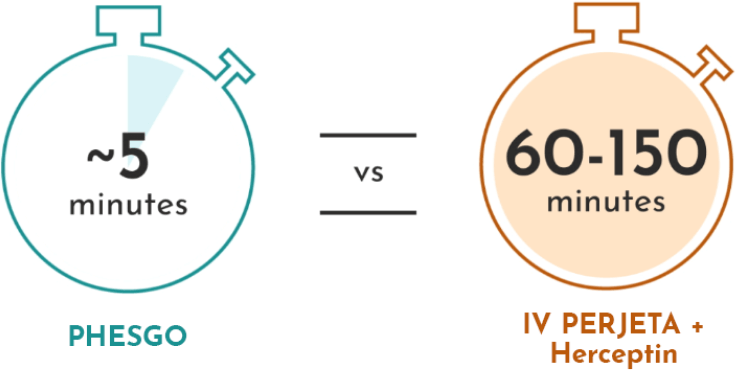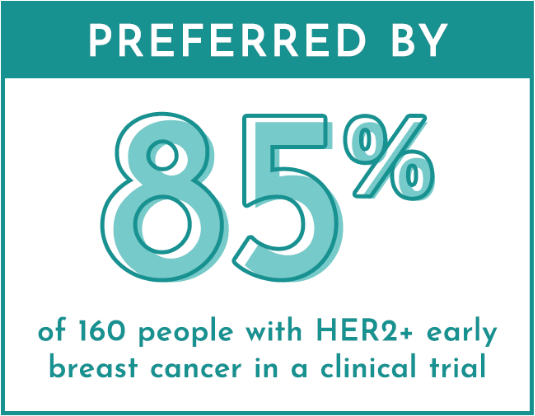| {{ Dear First Name }} |
| PHESGO offers an alternative way to get your HER2-positive breast cancer treatment. It brings together PERJETA® (pertuzumab) and Herceptin® (trastuzumab) in a single injection under the skin. When these drugs are given as an intravenous (IV) infusion, it takes about 60-150 minutes. PHESGO, on the other hand, can be given in about 5 minutes.* |
| PHESGO is given as part of a complete treatment regimen for HER2+ breast cancer that includes chemotherapy. |
|
|

|
| For PHESGO, your healthcare team will wait at least 30 minutes after the first dose, and at least 15 minutes after each following dose, to check for any reactions. If side effects occur, your healthcare provider may slow, delay, or stop your treatment. |
| What does PHESGO treat? |
| PHESGO® is a prescription medicine approved for use in combination with chemotherapy for: |
| • |
use prior to surgery (neoadjuvant treatment) in adults with HER2-positive, locally advanced, inflammatory, or early stage breast cancer (tumor is greater than 2 cm in diameter or node-positive). PHESGO should be used as part of a complete treatment regimen for early breast cancer. |
| • |
use after surgery (adjuvant treatment) in adults with HER2-positive early breast cancer that has a high likelihood of coming back. |
|
| PHESGO is a prescription medicine approved for use in combination with docetaxel in adults who have HER2-positive breast cancer that has spread to different parts of the body (metastatic) and who have not received anti-HER2 therapy or chemotherapy for metastatic breast cancer. |
| What are the most serious side effects of PHESGO? |
| • |
PHESGO may cause heart problems, including those without symptoms (such as reduced heart function) and those with symptoms (such as congestive heart failure). |
| • |
Receiving PHESGO during pregnancy can result in the death of an unborn baby and birth defects. |
| • |
PHESGO may cause serious lung problems. |
|
| Please see additional Important Safety Information below. |
|
| Results with PHESGO |
| In a clinical study of 500 people with HER2+ early breast cancer, no major difference was seen in the amount of medicine that went into the bloodstream with PHESGO compared to IV PERJETA + Herceptin. The combined results of the study showed no major difference is expected in how it works. |

|
| In another clinical study of 160 people, 85% preferred PHESGO over IV PERJETA + Herceptin. The most common reason was that it took less time in the clinic. The most common reason people preferred IV PERJETA + Herceptin was because it felt more comfortable during administration. |
| Currently receiving IV PERJETA + Herceptin? |
| You may be eligible to switch. Talk to your doctor to find out if PHESGO is right for you. |
| Remember, your doctor and your healthcare team are your primary sources of information. Only they can give you medical advice about your disease and treatment. |
|
|
|
|
| What does PHESGO treat? |
| PHESGO® is a prescription medicine approved for use in combination with chemotherapy for: |
| • |
use prior to surgery (neoadjuvant treatment) in adults with HER2-positive, locally advanced, inflammatory, or early stage breast cancer (tumor is greater than 2 cm in diameter or node-positive). PHESGO should be used as part of a complete treatment regimen for early breast cancer. |
| • |
use after surgery (adjuvant treatment) in adults with HER2-positive early breast cancer that has a high likelihood of coming back. |
|
| PHESGO is a prescription medicine approved for use in combination with docetaxel in adults who have HER2-positive breast cancer that has spread to different parts of the body (metastatic) and who have not received anti-HER2 therapy or chemotherapy for metastatic breast cancer. |
| What are the most serious side effects of PHESGO? |
| • |
PHESGO may cause heart problems, including those without symptoms (such as reduced heart function) and those with symptoms (such as congestive heart failure). |
| • |
Receiving PHESGO during pregnancy can result in the death of an unborn baby and birth defects. |
| • |
PHESGO may cause serious lung problems. |
|
| Please see additional Important Safety Information below. |
|
|
|
| Important Safety Information |
| What are the most serious side effects of PHESGO? |
| PHESGO may cause heart problems, including those without symptoms (such as reduced heart function) and those with symptoms (such as congestive heart failure). |
| • |
The risk for and seriousness of these heart problems are highest in people who received both PHESGO and a certain type of chemotherapy (anthracycline) |
| • |
Your doctor will check for signs of heart problems before, during, and after treatment with PHESGO. Based on test results, your doctor may hold or discontinue treatment with PHESGO |
| • |
Contact a healthcare professional immediately for any of the following: new onset or worsening shortness of breath, cough, swelling of the ankles/legs, swelling of the face, palpitations, weight gain of more than 5 pounds in 24 hours, dizziness or loss of consciousness |
|
| Receiving PHESGO during pregnancy can result in the death of an unborn baby and birth defects. |
| • |
Birth control should be used while receiving PHESGO and for 7 months after your last dose of PHESGO. If you are a mother who is breastfeeding, you should talk with your doctor about either stopping breastfeeding or stopping PHESGO |
| • |
If you think you may be pregnant, you should contact your healthcare provider immediately |
| • |
If you are exposed to PHESGO during pregnancy, or become pregnant while receiving PHESGO or within 7 months following the last dose of PHESGO, you are encouraged to report PHESGO exposure to Genentech at 1-888-835-2555 |
|
| PHESGO may cause serious lung problems. |
| • |
Your doctor may check for signs of lung problems including: |
| - |
Severe shortness of breath |
| - |
Fluid in or around the lungs |
| - |
Weakening of the valve between the heart and the lungs |
| - |
Not enough oxygen in the body |
| - |
Swelling of the lungs |
| - |
Scarring of the lungs |
|
|
| Who should not receive PHESGO? |
| • |
PHESGO should not be used in patients who are allergic to pertuzumab, trastuzumab, hyaluronidase, or to any of the ingredients in PHESGO |
|
| What are other possible serious side effects? |
| • |
PHESGO may worsen low white blood cell counts caused by chemotherapy: Low white blood cell counts can be life threatening and were seen more often in patients receiving Herceptin® (trastuzumab) plus chemotherapy than in patients receiving chemotherapy alone. Your doctor may check for signs of low white blood cell counts when he or she examines you |
| • |
PHESGO may cause administration-related reactions: PHESGO is given as an injection. The active ingredients in PHESGO have been associated with severe administration reactions, including hypersensitivity or anaphylaxis, which can be fatal. Talk to your doctor if you feel any symptoms. The most common symptoms include dizziness, nausea, chills, fever, vomiting, diarrhea, hives, swelling of the skin, breathing problems, or chest pain |
|
| What are the most common side effects? |
| The most common side effects of PHESGO when given with chemotherapy as part of an early breast cancer regimen are: |
| • |
Hair loss |
| • |
Nausea |
| • |
Diarrhea |
| • |
Low levels of red blood cells |
| • |
Weakness |
|
| The most common side effects of PHESGO when given with docetaxel for treatment of breast cancer that has spread to other parts of the body (metastatic) are: |
| • |
Diarrhea |
| • |
Hair loss |
| • |
Low levels of white blood cells with or without fever |
| • |
Nausea |
| • |
Feeling tired |
| • |
Rash |
| • |
Damage to the nerves (numbness, tingling, pain in hands/feet) |
|
| You are encouraged to report side effects to Genentech and the FDA. You may report side effects to the FDA at 1-800-FDA-1088 or www.fda.gov/medwatch. You may also report side effects to Genentech at 1-888-835-2555. |
| Talk to a healthcare professional for more information about the benefits and risks of PHESGO. |
| Please see full Prescribing Information for additional Important Safety Information, including most serious side effects. |
| If you cannot afford your medication, visit phesgo.com/financial-support for financial assistance information. |
|
|